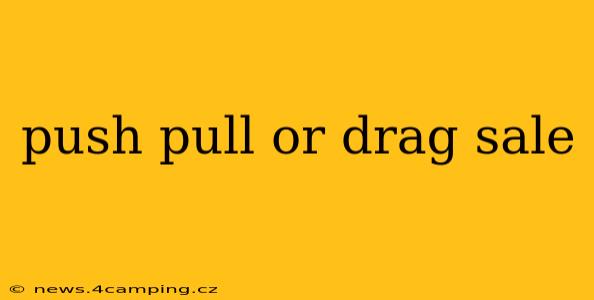Choosing the right sales strategy is crucial for business success. Understanding the nuances of push, pull, and drag sales can significantly impact your bottom line. This article will delve into each strategy, outlining their strengths and weaknesses to help you determine the best approach for your unique business needs.
What is a Push Sales Strategy?
A push sales strategy focuses on actively promoting your product or service to the customer. Think of it like pushing a product "out" to the market. This often involves direct sales efforts, such as:
- Direct sales teams: A dedicated sales force actively contacting potential clients, offering presentations, and closing deals.
- Trade shows and events: Participating in industry events to showcase your product and generate leads.
- Wholesale distribution: Partnering with retailers to stock and sell your product on their shelves.
- Aggressive advertising campaigns: Utilizing marketing channels like television, print, and radio to reach a broad audience.
Advantages of a Push Strategy:
- High control over sales process: You directly manage the sales cycle.
- Fast results: Aggressive promotion can yield quick sales increases.
- Ideal for new products: Introducing a new product to the market often requires a push approach.
Disadvantages of a Push Strategy:
- High costs: Direct sales, advertising, and events can be expensive.
- Potential for stockpiling: Over-promotion might lead to excess inventory.
- Limited customer engagement: It can feel impersonal and less customer-centric.
What is a Pull Sales Strategy?
A pull strategy relies on creating demand for your product or service. You "pull" customers towards your product by focusing on marketing and branding efforts that highlight its value and benefits. Common pull strategies include:
- Content marketing: Creating valuable content (blog posts, videos, infographics) to attract and engage your target audience.
- Search engine optimization (SEO): Improving your website's ranking in search results to increase organic traffic.
- Social media marketing: Building a community and engaging with your audience on social platforms.
- Public relations: Generating positive media coverage and building brand awareness.
Advantages of a Pull Strategy:
- Lower costs (long-term): While initial investment may be needed for content creation, long-term costs are often lower than push strategies.
- Stronger brand loyalty: Building trust and engagement leads to customer loyalty.
- More targeted approach: Marketing efforts focus on attracting customers actively seeking your product.
Disadvantages of a Pull Strategy:
- Slower results: Building brand awareness and generating demand takes time.
- Difficult to measure ROI: Attributing specific sales to marketing efforts can be challenging.
- Requires consistent effort: Pull strategies require ongoing content creation and engagement.
What is a Drag Sales Strategy?
A drag sales strategy is less common and often involves leveraging existing customer relationships or utilizing indirect sales channels to generate sales. This might involve:
- Referral programs: Encouraging satisfied customers to refer new clients.
- Affiliate marketing: Partnering with affiliates to promote your product.
- Leveraging existing network: Using your professional network to reach potential clients.
While not as clearly defined as push and pull, a drag strategy often combines elements of both, benefiting from existing relationships to drive sales.
What is the Best Sales Strategy?
The best sales strategy depends on your specific business, target market, budget, and product or service. Many businesses utilize a combination of push and pull strategies for optimal results. For instance, a company might use aggressive advertising (push) alongside a strong content marketing strategy (pull) to maximize reach and engagement.
It's crucial to analyze your customer journey and understand where your target audience is most receptive to your message. A well-defined target market and a clear understanding of their needs will guide you toward the most effective approach.
Which Sales Strategy is Most Cost-Effective?
Generally, a pull strategy can be more cost-effective in the long run compared to a push strategy. While the initial investment in content creation and SEO might seem significant, the long-term benefits of organic traffic and brand loyalty outweigh the ongoing costs of traditional advertising and direct sales. However, a push strategy can be more effective for immediate sales boosts.
What Sales Strategy is Best for B2B?
B2B sales often benefit from a combination of push and pull strategies. Direct sales teams (push) are often crucial for closing large deals, while content marketing (pull) plays a significant role in building trust and establishing expertise.
Which Sales Strategy is Best for B2C?
B2C sales often leverage a mix of strategies as well, but pull strategies often dominate due to their ability to reach a wider audience and generate brand awareness through social media, content marketing, and influencer partnerships. Push strategies, like targeted advertising campaigns, are also valuable in B2C.
By carefully considering these factors and understanding the strengths and weaknesses of each approach, you can create a successful sales strategy tailored to your unique business needs. Remember to track your results and adjust your approach accordingly.
